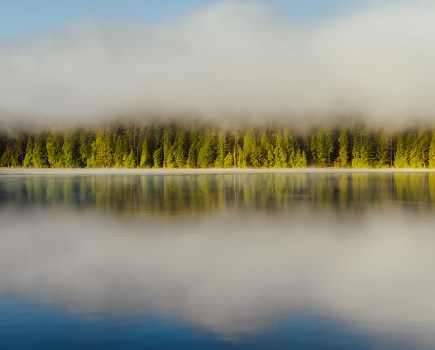Last year’s Christmas cover competition saw us inundated with a stunning and varied selection of winter images that were all in contention to grace the front page as the cover image for our Amateur Photographer Christmas Special issue.
Having the tricky task of only being able to pick one winning image, we felt it was a shame to let so many great pictures not have a chance to shine as well, so we’ve gathered our favourites together here for you. Not only that, but we’ve also spoken with each photographer featured to get some details about their shots, and asked them to pass on their own winter shooting tips that they’ve found indispensable in these colder months.
View Across the Cheshire Plains by Ed Rhodes
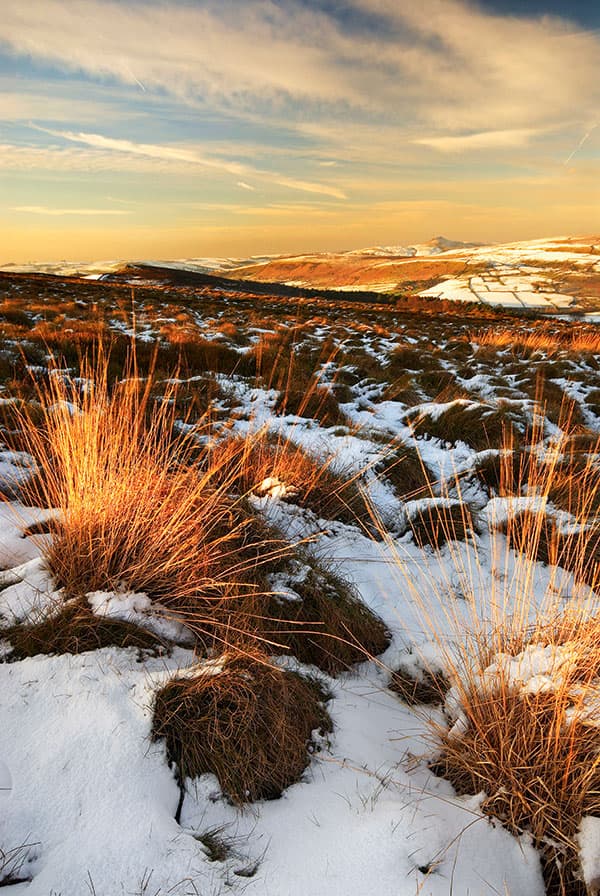
I discovered this view across the Cheshire Plains during the summer months while the heather was still in bloom. I decided then that I must revisit this place during winter, full of hope for a covering of snow. This was always going to be a challenging shot, as the area is only accessible by narrow and very steep roads. However, as the weather forecast was promising I decided to set off. The road conditions dictated I could drive most of the way there, but I had to complete the remainder of the journey on foot. My efforts were rewarded with a fabulous glowing, low sun, which set the scene as I had envisaged in my mind many months before.
The Sky at Night by Steven Sandner
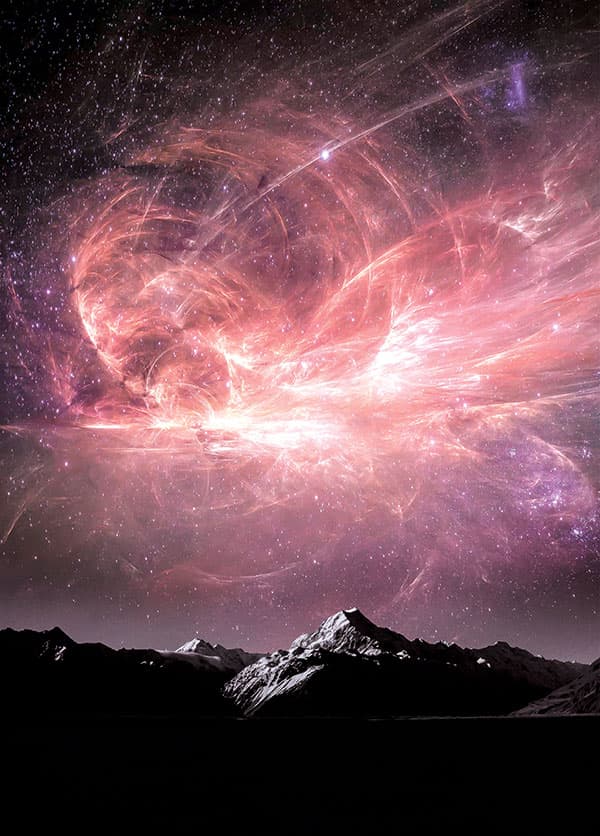
Night photography is probably one of the most challenging forms of photography and sometimes the most rewarding. It’s also an art form, as long exposures and the digital darkroom will yield results we cannot naturally see: auroras are brighter and more colourful; patterns emerge and the sky becomes a majestic chandelier of lights.
The most important step to taking good night shots is finding the right location – one devoid of light pollution, with an interesting backdrop such as mountains, lakes or rivers. Many entry-level cameras with aperture ratings around f/3.5 will be good enough to capture the Milky Way and Magellanic Clouds. Multiple exposures and image stacking will result in clearer nightscapes, allowing you to tease out any fine details. For star shots use manual focus, open your aperture as far as it goes (lowest f-number), shoot at ISO 1,600 for roughly 30-40 seconds, and remotely initiate the exposure. The universe becomes your canvas and the camera your brush.
Morning Post by Sarah Brooks
www.moonfruitphotography.co.uk
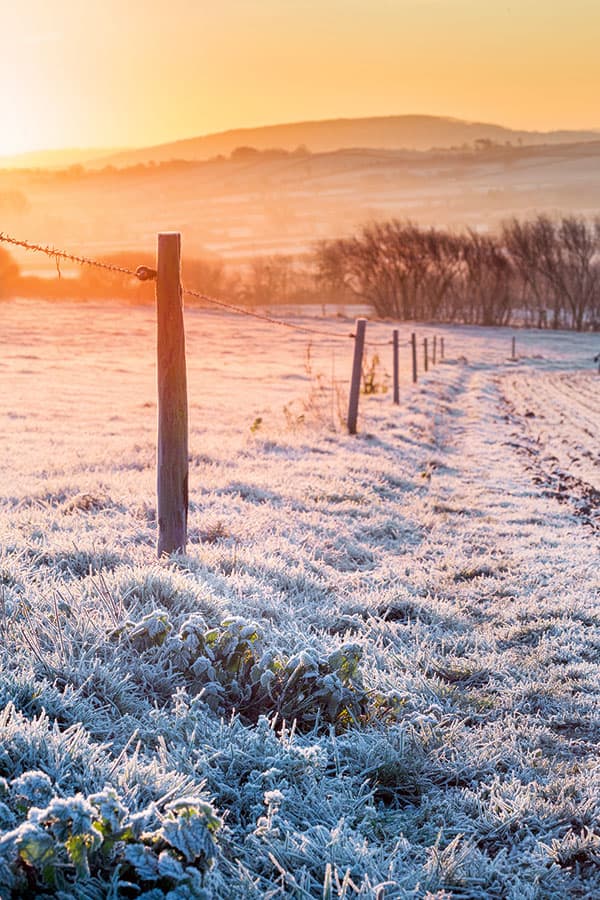
This is a winter sunrise taken in late December 2014. I hadn’t planned to go out that morning, but when I saw the thick frost and clear sky I quickly headed to a nearby location that I thought would be good. It’s handy to have some local spots in mind for situations where there isn’t time to travel far. Getting to know the local area, noting where the sun will rise and set throughout the year, and keeping potential compositions in mind can help to make the most of favourable conditions when they occur. Having essential kit ready to go is useful, too. I keep a set of warm clothes, a hat, scarf, gloves, and so on, along with my camera bag, so I’m able to leave quietly without waking the family.
Robin by Chris Nesbit
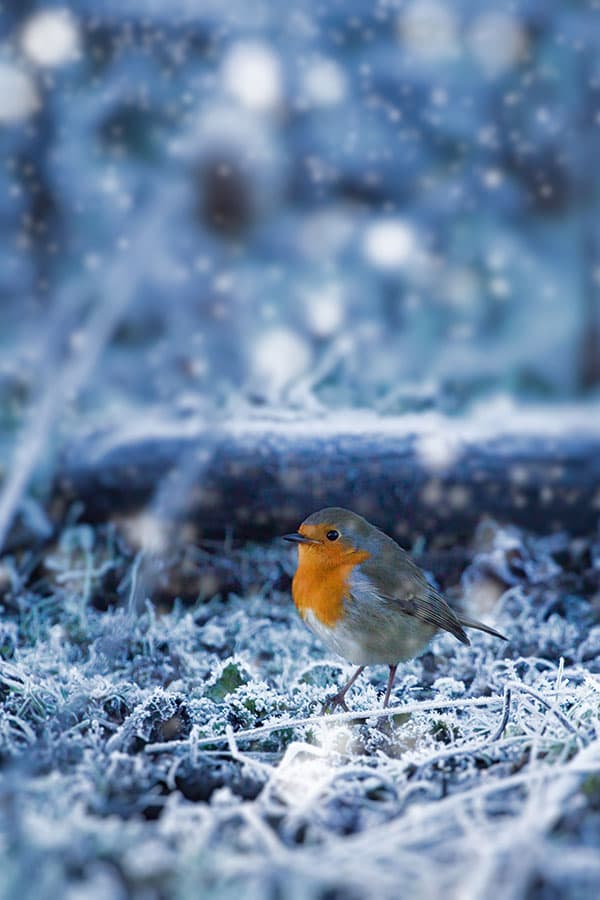
This shot of a robin, a much-loved species, epitomises the Christmas season for me: cold weather, frost and dense snow. In the midst of bleakness, the red-breasted robin stands out. It was taken early in the morning as I walked my dog along the Test Way in Hampshire. Robins can be extremely inquisitive birds, often following my dog to ensure he isn’t getting up to any mischief. They are also extremely territorial, so if you want to get a shot of a robin and know its location, you can revisit it over several days, knowing the bird should be there at some point.
Finding a position and composition, you can try to capture a shot with the knowledge that you can try again or adjust it over a few days if it’s not quite what you’re after. In the case of this shot, I was fortunate enough to get it the first time as the robin stood perfectly for me and the light was quite seasonal. Being along the river, and very cold, I would keep the camera in the warmth of my jacket to stop the lens misting over during the walk. I also carry a 36mm Kenko extension tube, which gives me the option to fire off some macro shots with minimal kit.
Snowy Tree by Chris Dale
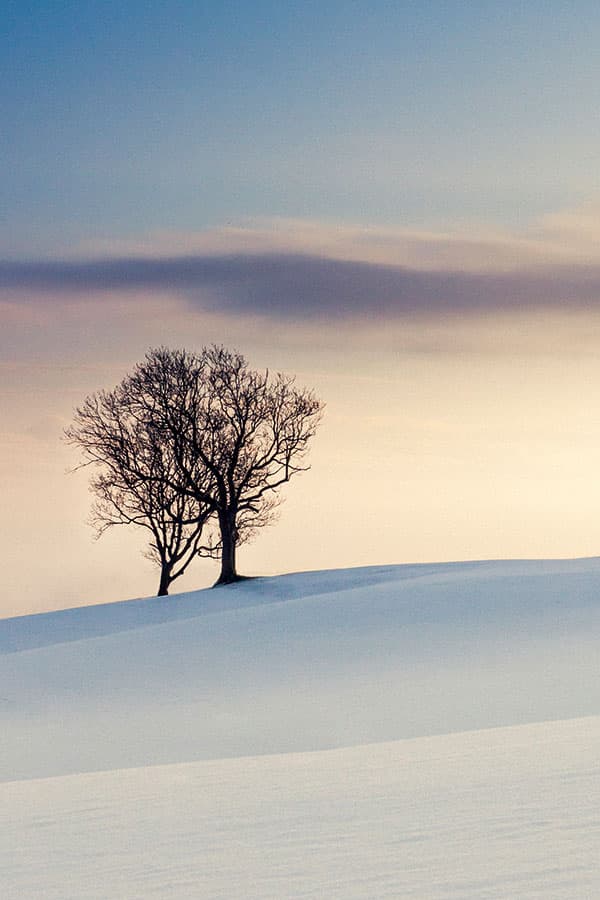
Winter brings some great opportunities for landscape photography, and a deep covering of snow is well suited to minimal compositions such as this one as it gives clean, simple lines and tones. To make the most of this, look for a clear horizon as well as interesting shapes and layers in the snow.
Shooting raw is a huge advantage with snow, as it’s easy to get the white balance wrong and the amount of bright white in the scene can make exposure tricky. Having more control to tweak these or recover detail during post processing can make a big difference.
This photo was taken on a local golf course early in the morning to get some warmer colour in the sky that balances the cold blue tones. To push the minimal feel I spot-removed a few areas where long grass was peeking through the snow and a small section of the horizon where fields could be seen in the distance.
Tree-lined Avenue by Sarah Lewis
www.purplefacephotography.co.uk
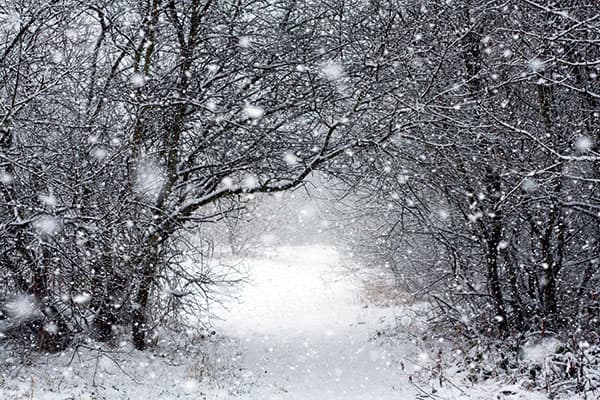
In an effort to keep my camera dry and warm (to avoid depleting the batteries), I wrapped it up in a scarf. I know… it’s not what the professionals do, but it was warm and kept most of the important buttons dry.
What drew me to taking this shot is the way the branches arch over one another, and the way the snowflakes were so big – they weren’t hard to photograph. A lot of the comments I received on this photo said the snowflakes look fake, as if they were added in afterwards, but these are definitely real. Regarding post-processing, I didn’t want to do much apart from a slight change in exposure. I deliberately underexposed the shot so the whites wouldn’t get blown out. I then simply brightened the image in Photoshop – and voilà! I contemplated desaturating the image, but I preferred the slight blue cast and the very subtle orange piece of grass at the bottom of the shot.
Frosted Grass Snail and Frosted Man by George Wheelhouse
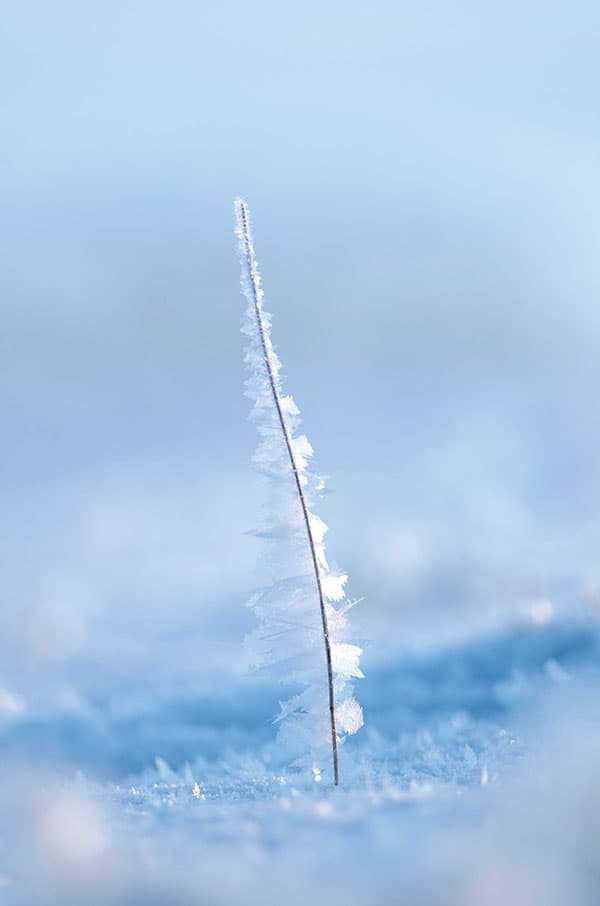
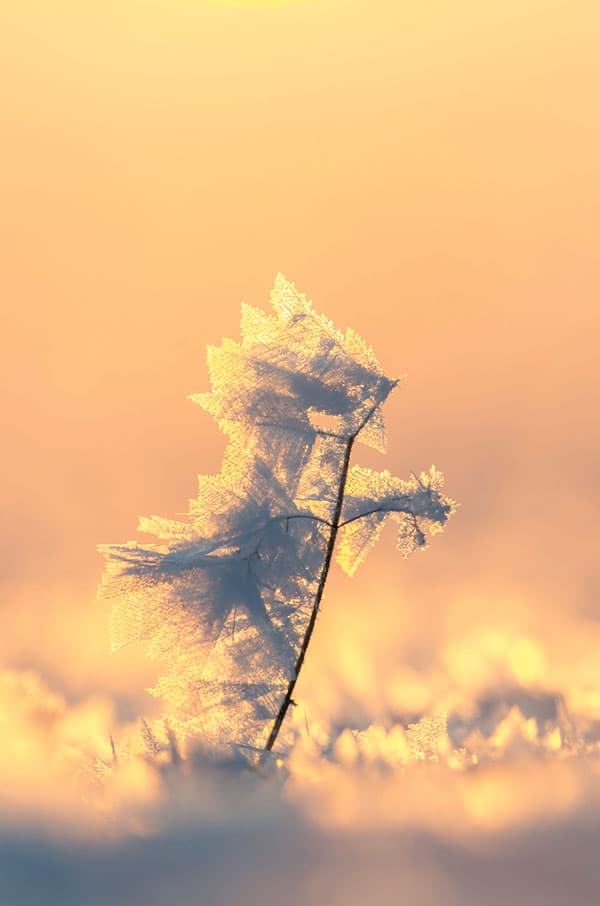 Winter can be a great time to find patterns in nature and if you come across unique weather effects such as this, take advantage of
them and make photos you haven’t done before. I was out on a very cold morning looking for deer, but these amazing scenes of frosted grass were a complete distraction.
Winter can be a great time to find patterns in nature and if you come across unique weather effects such as this, take advantage of
them and make photos you haven’t done before. I was out on a very cold morning looking for deer, but these amazing scenes of frosted grass were a complete distraction.
There were so many interesting patterns in the hoar frost that I started to look for some that took on the appearance of something else. Some were quite simple, like the one on the left, but then I found one that looked like a little stickman (right), and by shooting from this angle I was able to use back-lighting to bring out detail in the delicate crystalline structure. I had to underexpose this to retain the highlights, but I lightened the shadows so as not to have a result that’s too contrasty.
Thirlmere Sunset by Anita Nicholson
www.anitanicholsonphotography.com
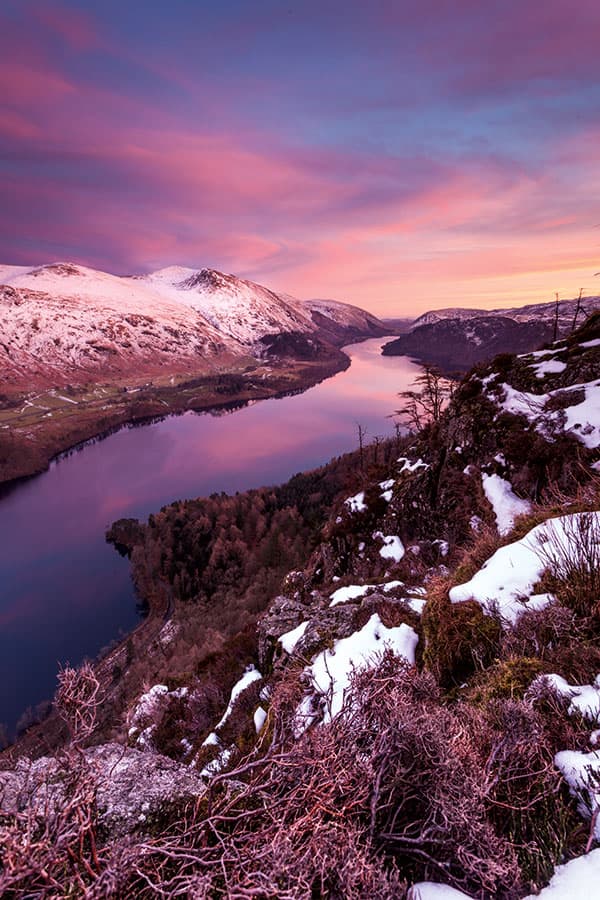
My other half and I are landscape photographers who love hiking and exploring the great outdoors. Over the past couple of years we have combined our love for photography with our love for exploring the Lake District by taking up wild camping, which has enabled us to stay in the places we love even longer. Wild camping is fantastic – it’s hard work carrying hiking, camping and photography gear up the fells, but the experience of being up there and taking in both sunset and sunrise, and potentially star-filled skies, makes it worth it.
This was taken on a camping trip one still, snowy winter night last February. The conditions looked perfect for a camp trip, so we packed up our gear and headed for Raven Crag, a lovely fell in the Lake District. Raven Crag may be a little fell, but the views over to the Helvellyn range and along Thirlmere are outstanding. Once we set up camp for the night, we had a cup of coffee to warm up and waited to see what sunset would do. It looked like it wouldn’t do much, and had we been on just a day hike we would have probably climbed back down the fell and headed home. But shortly after sunset the sky started to glow pink, so we jumped into action, taking photos as the pink light filled the sky around us and lit the snow on the fell tops, the colour lasting for a good hour. It was an amazing sight, and one we may have missed had we not been camping on the fells.
Wild camping is a challenge, but if you love the great outdoors and landscape photography it is a fantastic adventure, and you will more than likely come home with a rewarding collection of images. Wild camping in winter is especially magical – it’s a wonderful experience.
Carrick Fell Bog by Anita Nicholson
www.anitanicholsonphotography.com
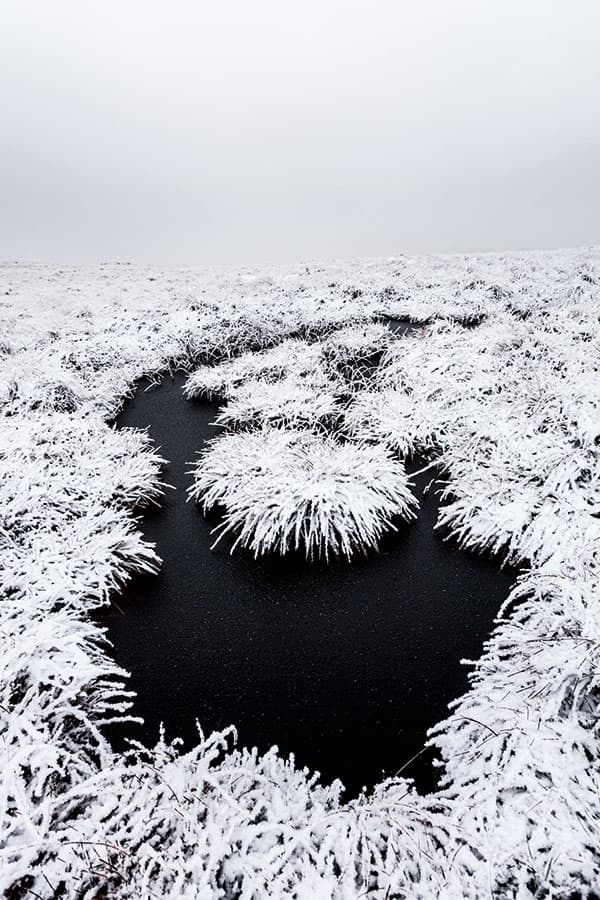
It’s fair to say that most landscape photographers love winter photography, especially taking pictures of snowy or frosty scenes. Last winter in Northumberland, we barely had any snow so we headed over to the Lake District for our snow fixes. As soon as we heard reports of snow falling in the Lakes, we headed straight over and up onto the fells so as to get above the snowline. This shot was taken on our last hike of the Northern Fells (we are steadily completing all the Wainwrights, which are the 214 fells described in Alfred Wainwright’s book), up Carrock Fell and along to High Pike, then back.
As we approached the top of Carrock Fell, a snowstorm enveloped us and we lost the distant views. This did, however, give us a lot more fresh snow and a wonderful soft lift. As we hiked passed Carrock Fell summit, the ground became boggy. The black peaty bogs looked fantastic against the fresh crisp snow. This bog, with its tufts of grass and intense dark inkiness, caught my eye, so I stopped to take shots of it. I used a wideangle so I could get up close to the bog and still get it all in shot, and a Lee 0.9 hard grad as we were in the cloud and it was very white while the light was soft. After taking a couple of shots we quickly headed on.





